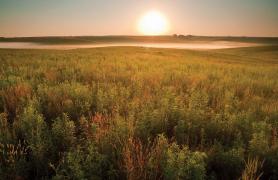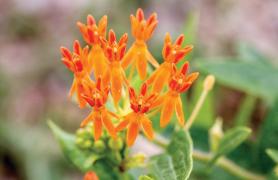What Is It?
Our photographers have been busy exploring the intricacies of outdoor Missouri. See if you can guess this month’s natural wonder.

Ask MDC
- Address: PO Box 180, Jefferson City, MO 65102-0180
- Phone: 573-522-4115, ext. 3848
- Email: AskMDC@mdc.mo.gov
What is this?
Q. This beautiful blossom, known as Ozark witch hazel (Hamamelis vernalis), is one of spring’s earliest signs.
A. No taller than 9 feet, typically, this shrub occurs naturally in gravel and dry streambeds and at the bases of rocky slopes along streams in southern Missouri. It’s also widely cultivated because of its amazing ability to bloom as early as January. Even as snow still clings to the landscape, the branches of this shrub erupt in fragrant, yellow to dark-red blossoms, which sometimes cluster together and other times spring forth solitarily.
Ozark witch hazel differs from its closely related relative, eastern witch hazel (H. virginiana), which produces flowers in late autumn to early winter. Both species are used to make witch hazel extract, an ingredient prized for its astringent and anti-inflammatory properties. Deer also like to eat the shoots and leaves.
Q. We have a woodpile that we need to tidy up, but I am concerned about uncovering a snake. Are we safe to clean it up in January?
A. It’s unlikely a snake would overwinter in a woodpile, since such an above-ground hideaway offers only minimal protection from the cold. If you do find the rare hibernating snake, it’s unlikely to move fast, if at all, due to January’s frigid temperatures. Finally, most snakes in Missouri aren’t venomous.
Snakes are ectothermic, or “cold-blooded.” They use their surroundings — sun, rocky crevices, water, and shade — to maintain stable body temperatures. Going underground in the winter doesn’t mean they’re inactive or asleep like some mammals. Technically, reptiles do not hibernate. Instead, they undergo a simpler process called brumation. Unlike hibernation, which involves several metabolic changes over several weeks, overwintering reptiles raise or lower their activity in response to changes in their surroundings.
Q. We have a pair of nesting bald eagles behind our house. They have wintered here since 2013. They usually come in early fall and leave in late spring. Last summer they didn’t leave. Why didn’t they go?
A. It is not unusual for bald eagles, especially mature adults, to remain in the area year-round. This decision is largely dependent on age, weather conditions, and food availability.
If weather conditions are amenable, this pair of mature adult eagles may remain throughout the winter to defend their nesting site. However, if conditions change, they may disperse farther south and hopefully return once again in the spring to nest.
Immature eagles — younger than 4 years old — are more nomadic and will migrate and disperse more often than adults, since they don’t have a nesting site to defend.

Agent Notes
New Year’s Resolutions
Love them or hate them, at some point most of us have tried and failed at keeping our New Year’s resolutions. Resolutions may include better health, spending more time with family and friends, learning something new, or reducing stress. Believe it or not, the Missouri Department of Conservation can help you achieve these goals.
No matter the weather, no matter the season, the Missouri Department of Conservation manages hundreds of conservation areas, nature centers, and shooting ranges across the state for people to visit and explore. Some areas may include miles of hiking trails or primitive camping opportunities, while other areas may provide excellent hunting and fishing or wildlife viewing opportunities. Some facilities include a variety of indoor interactive displays and exhibits. We also offer many educational and outdoor skills classes.
So this year, get up, get out, and spend the day fishing with family, learning Dutch-oven cooking with your friends, improving your shooting skills on a trap range, or taking a walk along an interpretive trail. By regularly visiting our conservation areas, maybe this will be the year you achieve your New Year’s resolutions. To find an area near you, visit mdc.mo.gov/atlas.
Kevin Zielke is the conservation agent for Greene County. If you would like to contact the agent for your county, phone your regional conservation office.
What Is It?
American Bison

Bos bison
Extirpated from Missouri, bison were reintroduced to Prairie State Park in Barton County and The Nature Conservancy’s Dunn Ranch in Harrison County. The small herd of about 100 bison at Prairie State Park is considered wild because they reproduce naturally and graze freely. Bison are the largest mammal that still survives in North America, weighing between 900 and 2,200 pounds. Bison have a dark brown, shaggy coat. Both males and females have short, upcurved horns. Juveniles are lighter in color. Bison graze on grasses, sedges, and other plants. Because their herds can completely graze an area quickly, they migrate constantly. Mating occurs in late summer, and one calf is born the following spring. Calves nurse for a year, becoming mature at age 3. At this time, males leave their mothers and live alone or join a bachelor herd. Upon breeding season, herds of males and females approach each other again. —photograph by Noppadol Paothong
Also In This Issue


And More...
This Issue's Staff
Art Director - Cliff White
Associate Editor - Bonnie Chasteen
Staff Writer - Heather Feeler
Staff Writer - Kristie Hilgedick
Staff Writer - Joe Jerek
Photographer - Noppadol Paothong
Photographer - David Stonner
Designer - Les Fortenberry
Designer - Marci Porter
Designer - Stephanie Thurber
Circulation - Laura Scheuler






















